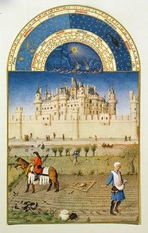 I’ve spent the past few weeks in jail. Or more precisely, a medieval dungeon.
I’ve spent the past few weeks in jail. Or more precisely, a medieval dungeon.
It’s too early to talk about the specifics of my next book. But I can say that a fair bit of it takes place in the keep of the Chateau of Vincennes.
A Fascinating Place
Most famous for its appearance in the Duke of Berry’s Book of Hours, the tower was once home to Charles V, who had been born there in in the 14th century. I first became fascinated by Charles V in graduate school. I took a course on the history of science in the Middle Ages. (Yes, there is such a thing as medieval sciences. The Dark Ages were not as dark as most people think.) 
I remember writing a seminar paper on Charles V’s contributions to early libraries. The collection of manuscripts that he kept at Vincennes was unrivaled. Eventually they were transferred out of the tower at to the Louvre and became the foundation of what is now the Bibliothèque Nationale de France (BNF).
Into a New Space
In 1666, Jean-Baptiste Colbert established the King’s Library in his home on the Rue Vivienne, where library remained until 1999. I can’t begin to tell you of my nostalgia for the many hours, days, months I’ve spent in
Bibliothèque Nationale’s small, stunning 19th-century reading room before the move.
 The library’s transfer to the massive Tolbiac compound brings far less nostalgia. The place is huge. And, built
The library’s transfer to the massive Tolbiac compound brings far less nostalgia. The place is huge. And, built
deep into the ground, it makes you feel like you are trapped in a ultra-modern bomb shelter. It doesn’t help that the place has not aged well over the 15 years since it opened. I was stunned by how trashed out it was when I was there last summer.
Fortunately, with all that is now available in the BNF’s digital collections, I haven’t had to be subjected to the place much. The strangely efficient digital reproduction services for manuscripts has also been a huge boon for my work.
Out of the Reading Room, into the Dungeon
But back to the dungeon. From the late sixteenth century to WWII, the Tower of Vincennes served as one of the most notorious prisons in France.
The Tower has four turrets, one at each corner. A narrow and winding stone staircase fills one of the turrets. In the others, there is a small room on each floor. On the first few floors, these rooms had served as chambers for Charles V’s trusted advisors or as meeting rooms. The high, arched ceilings and walls were painted in rich indigo and burgundy. The rooms on the upper floors housed archers who stood guard
Later, the grandeur of the Tower gave way to great suffering. Prisoners paced the rooms nervously as they waited interrogation and eventual sentencing. Over time, the rich royal paint gave way to graffiti. Prisoners scribbled messages, prayers, and obscenities on the walls. Some marked time in hash marks.
This spring, I was lucky to get a private tour of the upper floors of the tower. They are usually closed to the public because the graffiti is so precious.
In my Editor’s Column next week, I’ll share some images of some of the more stunning bits that I found on those walls.
